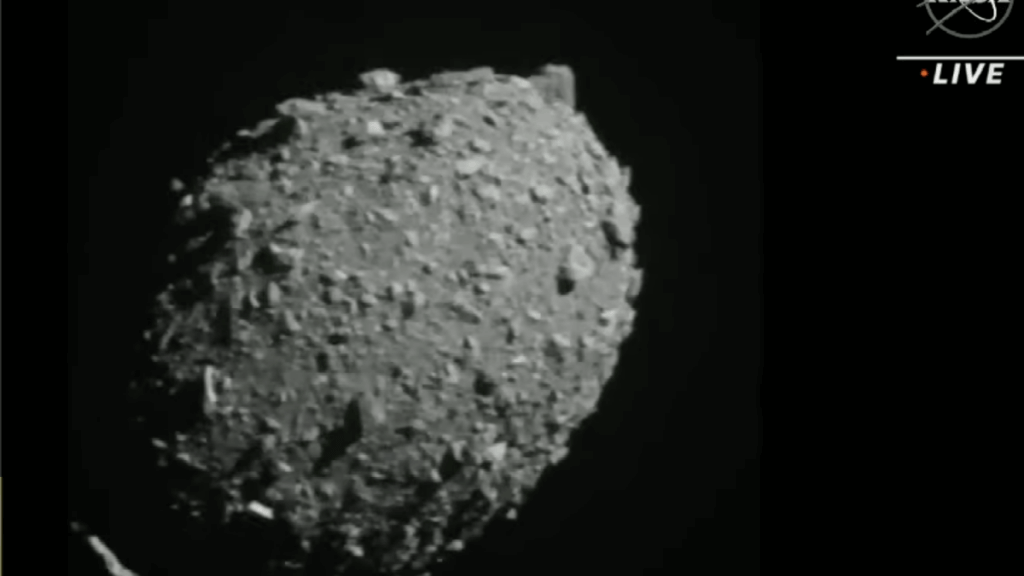While most folks were sitting down for supper, NASA tried to move a space mountain.
Beyond sight for backyard stargazers, a spacecraft the size of a vending machine self-destructed by ramming into a harmless asteroid shortly after 7 p.m. ET Monday. The high-speed crash was part of the U.S. space agency’s Double Asteroid Redirection Test, or DART.
The moment of impact marked the first time in history humans have attempted to alter the path of an asteroid, a flying chunk of rubble left over from the formation of the solar system about 4.6 billion years ago. Most of the time, these ancient rocks pose no danger to Earth, including Dimorphos, the one NASA just used for target practice. But at least three have caused mass extinctions, the most infamous of which wiped out the dinosaurs.
Stegosaurus didn’t have NASA.
“We are changing the motion of a natural celestial body in space. Humanity has never done that before,” said Tom Statler, program scientist. “This was the substance of fiction books and really corny episodes of Star Trek from when I was a kid, and now it’s real.”
NASA broadcast the $330 million carefully orchestrated collision, giving viewers a deer-in-headlights experience. Through a camera on the spacecraft, the team of scientists and engineers, as well as the general public, were able to watch a 525-foot rock grow from a mere dot of light to a rocky egg-shaped boulder blotting out the whole frame. The feed almost unfolded in real time, with perhaps just a 45-second delay, delivering an extreme closeup of an event happening 6.8 million miles away.
It was the first time anyone had ever actually seen what Dimorphos looked like, and teammates were delighted to finally get a look — this asteroid they had only known through data.
For the last four hours of the spacecraft’s life, it flew on autopilot, guided ever closer to certain doom. The spacecraft, about 1,300 pounds, carried no explosive devices on its back. Like an animal raised for slaughter, no one had given it a name. Its “weapon” was its own body and the sheer force of plowing into an asteroid at 14,000 mph.
The images beamed down to the mission operations center at Johns Hopkins Applied Physics Laboratory in Maryland abruptly cut out after the metal box met its demise.
“As we hit the last two minutes, where we could no longer command the spacecraft, and you knew we were on the trajectory, and you knew that we were not going to do anything to change it, it was just joy,” said Ed Reynolds, DART project manager at APL. “You got to enjoy the moment.”
The first planetary defense exercise — at least the impact part of it — was successful. Mission managers said early data shows the spacecraft was just 18.5 yards off from dead center when it struck. But whether DART was truly a triumph, able to shove the asteroid off its trajectory, won’t be known for some time.
Want more science and tech news delivered straight to your inbox? Sign up for Mashable’s Top Stories newsletter today.

Credit: NASA / Johns Hopkins APL / Steve Gribben
A planetary defense scheme
Scientists have likened the mission to running a golf cart into the Great Pyramid of Giza. If it worked, the spacecraft’s whack left a crater behind but didn’t blow the asteroid to bits. The LICIACube, a toaster-size spacecraft supplied by the Italian Space Agency, will fly by the disaster site three minutes later and take pictures of the damage.
NASA chose Dimorphos for the mission because it was an ideal specimen for tracking the results of DART’s hit. It has likely had the same orbit, looping around a larger asteroid, Didymos, for thousands of years — perhaps until now.
“This was the substance of fiction books and really corny episodes of Star Trek from when I was a kid, and now it’s real.”
Millions of space rocks orbit the sun. The majority are in the main asteroid belt between Mars and Jupiter, but occasionally rocks get nudged into the inner solar system, relatively closer to Earth.
There are currently no known asteroids on an impact course with our planet. Scientists are, however, keeping a vigilant eye on 30,000 large objects out there and estimate there could be 15,000 or so more waiting to be discovered. Using powerful telescopes, these astronomers are currently finding around 500 new sizable space rocks in Earth’s solar system neighborhood each year.
“An asteroid impact is an extremely rare event. Maybe once a century is there an asteroid that we would really worry about and want to deflect, and only maybe once in 1,000 years an asteroid the size of Dimorphos, on average,” said Lindley Johnson, planetary defense officer for NASA.
But even smaller rocks can cause immense destruction. An impact by an asteroid some 100 to 170 feet wide would destroy a place like Kansas City. An undetected meteor exploded over Chelyabinsk, Russia, in February 2013, causing an airburst and shockwave that affected six cities and injured 1,600 people. The rock was just 60 feet across, according to NASA.
Astronomers will use ground-based telescopes to study Dimorphos after the impact and take new measurements. The asteroid is known to travel around its companion every 11 hours and 55 minutes. Scientists hope the spacecraft shaved off about 10 minutes from its usual orbit.
It could take up to two months to confirm. But proving the space program has the technology to shove an asteroid out of the way could one day lead to a future mission to thwart an asteroid — decades in advance of a potential problem.
“So that we don’t ever have to worry about that one anymore,” Johnson said.

